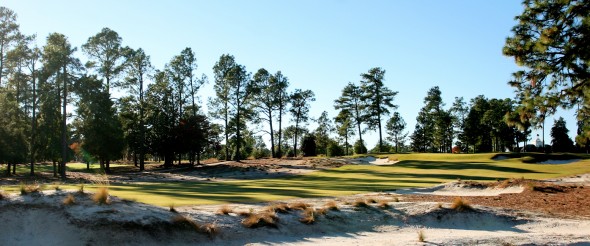
US Open, Pinehurst Preview
The numbers that decorate the leader board at the US Open are normally black. Black for bogey – over par scores are the norm and anything close to par at the end of the week is usually in with a chance. But this year there are murmurings that the course at Pinehurst No.2 will yield more than its usual sprinkling of red numbers, as the ‘thick rough’ setup will apparently be relaxed a little. So can we expect better scoring?
By the sounds of it, Pinehurst No.2 will present an entirely different challenge to Merion last year, and the theory goes that the lighter rough, especially around the greens, will be less penal and as a consequence the scores will be lower. No more chipping out sideways or uncontrollable hacks with fingers crossed.
But I am not so sure. The heavy rough of Merion may be absent but the course is monstrously long at over 7,500 yards and Pinehurst No. 2’s greatest defence comes in the form of its notorious ‘upturned saucer’ greens. And while the traditionally brutal US Open rough may have gone, in comes scrappy, sandy waste areas, courtesy of renovations carried out by Bill Coore and Ben Crenshaw. Knowing the USGA, I’m not so optimistic that the pros can look forward to an easier ride this year.
If the rough had stayed, I think Pinehurst 2014 may have been a blood bath, but those who enjoy watching the leading players in the world tough it out in a war of attrition may still get their wish. While I’m not a sadist, I do feel the US Open set up should demand the ultimate patience and serve as the greatest test of the year on the PGA Tour, otherwise it’ll feel like any other tournament. We see enough birdies during the year and occasionally it’s nice to watch an exercise in damage limitation.
Some of the other motivations behind the recent changes at Pinehurst are worthy of note too, as they have far wider implications for the US Open and the game as a whole. For instance, one of the reasons for the sandy wire grass areas off the fairways, as opposed to the thick rough with which we are accustomed, is the irrigation requirement. These hardy grasses require far less water to survive and therefore less maintenance. This won’t get anything more than the briefest mention in coverage, if they say anything at all, but it may be an example that others should be following (where Nature allows), with water conservation an increasing concern in the building and running of golf courses.
In my opinion there’s a negative side to the changes, however. The lack of rough has “necessitated” (I am never entirely sure that’s true) an extension of the course that plays long even by US Open standards. Not many amateurs play courses stretching beyond 7,000 yards, so 7,500+ with four par fours on the wrong side of 500 yards becomes something of an unfamiliar game. From the spectators’ view, it also runs the risk of becoming a slugger’s paradise and benefitting brute force over finesse. For me, one of the enduring and unique attractions of the sport has always been the ability (cash and access concerns aside) for the rest of us, the mortals, to play the very same course as the greats of the game and to marvel at their genius even more. No one will be playing Pinehurst like this again – at least not until the US Open rolls around again. Can you imagine the pace of play, not to mention the crushed spirits, of the amateur ranks attempting to take on a course like that?
And speaking of the US Open rolling around again, that brings me neatly to what I see as another plus for this year’s event. While the yardage will be shorter, Pinehurst No. 2 is set to host the ladies for their US Open the following week. I don’t think the media has made as much of this as they should have. What with the (potential) historic change at the R&A when they vote in September on allowing female members, this is the first time that the men’s and women’s US Opens will be played back-to-back on the same golf course. Short of playing in the same tournament, which I doubt anyone wants, its great exposure for the women’s game and pretty close to equal footing. I like to think the prospect of seeing how the ladies handle the same course will spark greater interest, but time will tell.
So this year we have two weeks rather than just one of watching the very best in the game make their birdies, bogeys, even triple bogeys, in their attempts to claim the US Open crowns. Who will become King and Queen remains to be seen but what is for certain is the message the USGA is looking to convey – that equality, conservation and participation are at the heart of their decisions – and that’s no bad thing.